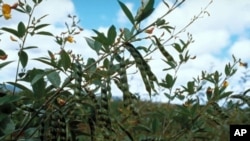A new study finds that governments can reduce the amount they spend on fertilizer subsidies - and free up resources for health, education or other priorities - by encouraging farmers to alternate maize with certain bean crops.
Scientists in the chronically-malnourished African nation of Malawi developed farming methods that produce the same yields using just half the fertilizer - a big potential saving for the Malawi government, and a potential model for other developing-countries.
But critics say poor farmers would do better right now using more synthetic fertilizer, not less.
In recent years, Malawi has taken major steps to increase its faltering food production by making synthetic fertilizer and high-yielding maize seed available to farmers at a steep discount. Nationwide, the program has been credited with increasing maize production by up to 30 percent.
High costs
But the costs of the project consume about one-sixth of Malawi's national budget.
"There's a lot of concern by the Malawi government in what is the sustainability of this," says Michigan State University crop scientist Sieg Snapp, "because if you invest in fertilizer, then there is less ability to invest in education and roads, other things. Obviously, there are tradeoffs."
Snapp and her colleagues wanted to see if farmers and governments could get more value from their fertilizer investments by adding bean crops known as legumes to the planting schedule.
Farmers have long known that legumes naturally fertilize the soil with the nitrogen they produce. But they have also known that legumes typically don't provide the kind of productivity boost possible with synthetic fertilizer.
The power of pigeon pea
Snapp's research focused on a different kind of legumes: shrubby legumes like pigeon pea and mucuna that mature more slowly than other legumes. That means they spend more time in the ground producing nitrogen fertilizer. And the ground stays covered with living plants for longer -- another benefit for the soil.
So when farmers grow maize the next year and add the normal amount of synthetic fertilizer, the soil is rich and ready. In the study published in The Proceedings of the National Academy of Sciences, Snapp says the maize-and-shrubby-legume rotation produced as much grain as growing maize with synthetic fertilizers both years.
"We're producing the same amount of grain," she says, "but...at half the amount of fertilizer."
Reliably profitable
Spending less on fertilizer helped make the shrubby legume rotation three to four times more profitable, which Snapp says is critical if farmers are going to change their practices.
Plus, she adds, yields from the shrubby legume rotation were more reliable year after year.
"A lot of people just focus on the production," she says. "But if it isn't stable, it isn't every year you can count on that, that puts your country at risk."
Snapp says the shrubby legume rotation can reduce the risk of food shortages at lower cost -- to farmers and national governments -- than expensive synthetic fertilizers.
Synthetics more powerful
Glenn Denning is a specialist in agriculture and food security at Columbia University's Earth Institute. He agrees that legumes serve important functions improving the soil and providing a source of protein.
"But I don't think this is the right time to de-emphasize fertilizer use in Malawi, or anywhere else in Africa, for that matter," he says.
Denning says even with the subsidy-driven increase in fertilizer, maize yields in Malawi are still far below what they could be. And he says farmers could apply twice the fertilizer used in Snapp's study and increase their yields more than they could with legumes.
That would free up land for other crops. "And in that way," he adds, "small-scale farmers, instead of devoting their whole land area to maize simply so they've got enough to survive on, they could devote half or two-thirds of their land to maize and the rest they could put into other crops, including legumes."
Complement, not replace
Denning notes that pigeon peas are an important part of the cropping system in a major project he works on in Malawi. He says they do have potential in the government's subsidy program.
"I think you could cut your costs in some places where these legumes will really make a difference." But, he adds, "I think the jury would still be out as to how widespread you could effectively introduce those legume rotation systems at this time."
Current pigeon pea varieties do not grow well in many parts of the country, he says.
Denning expects legumes will play a bigger role in fertilizer subsidy programs. But he says they should complement, not replace, synthetic fertilizers.
